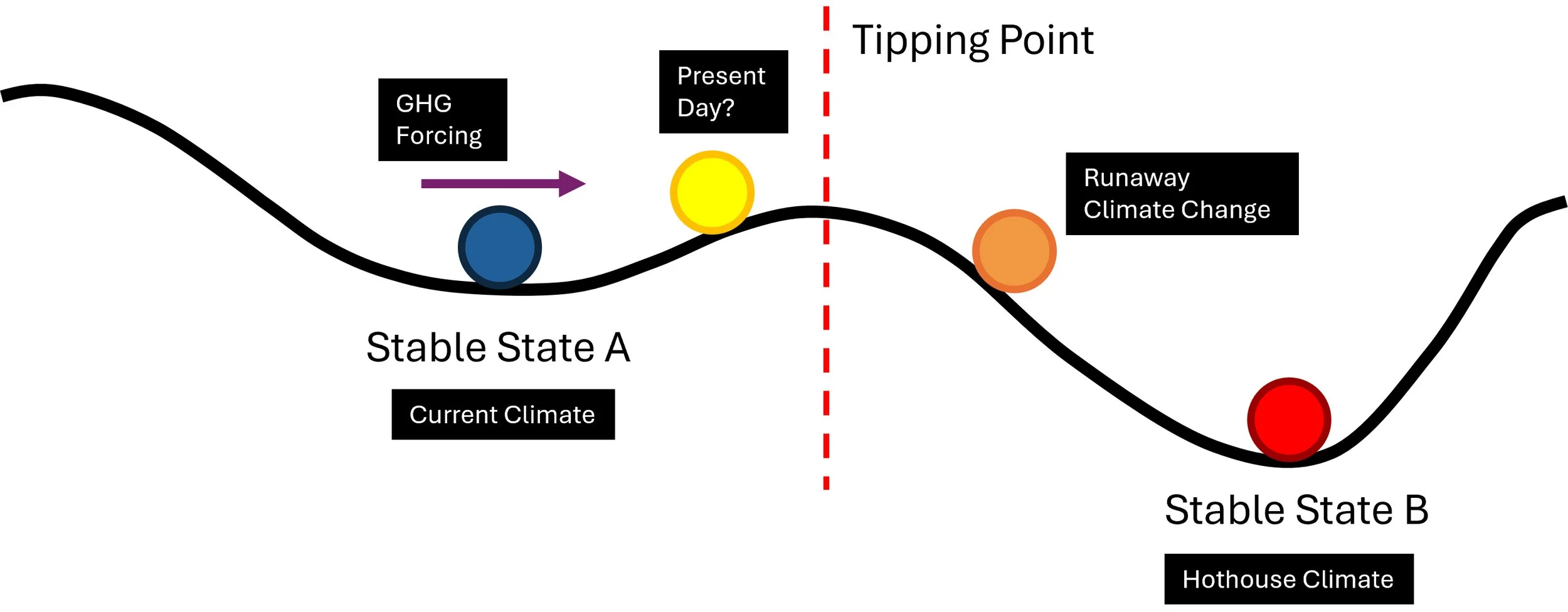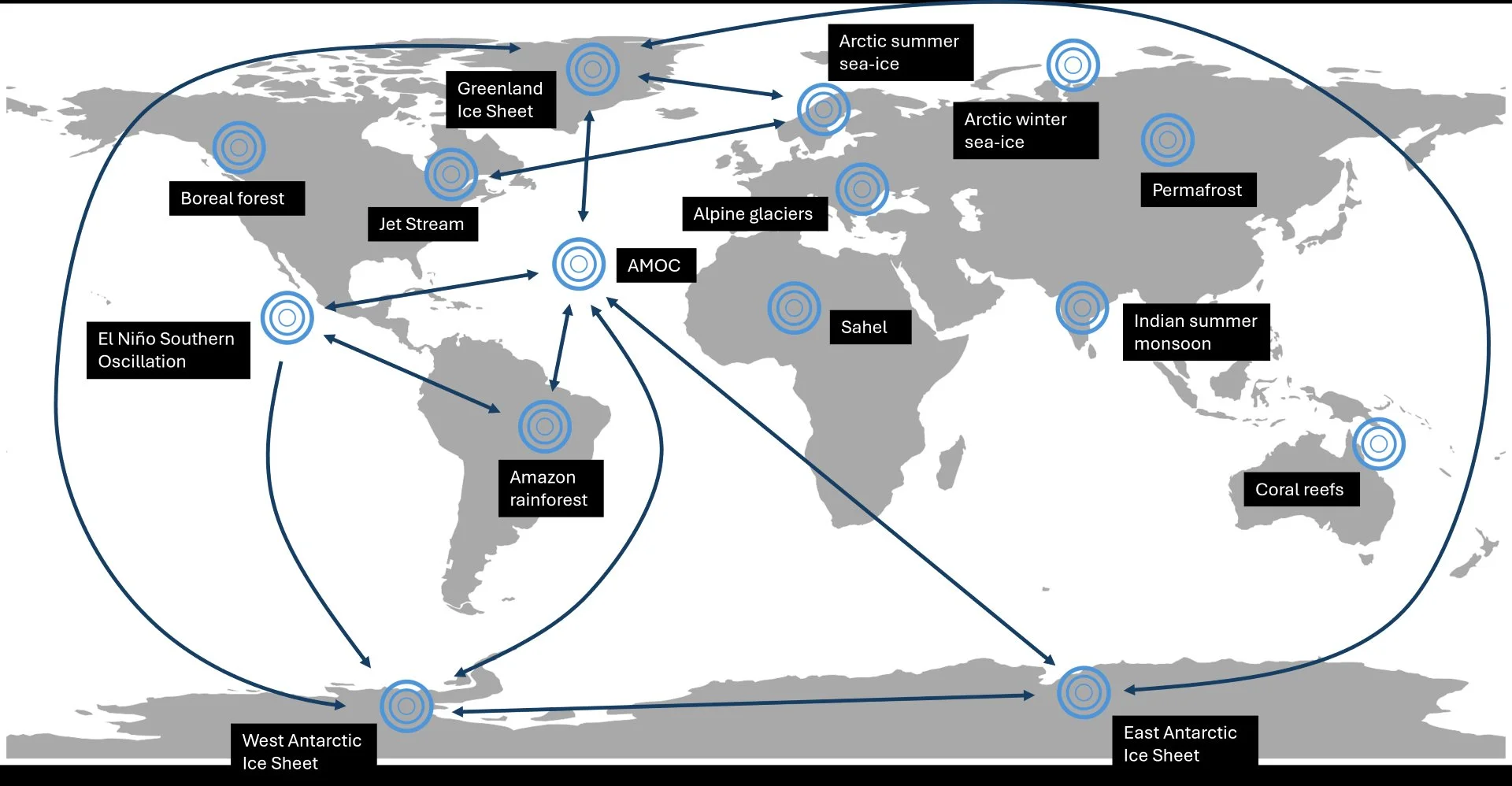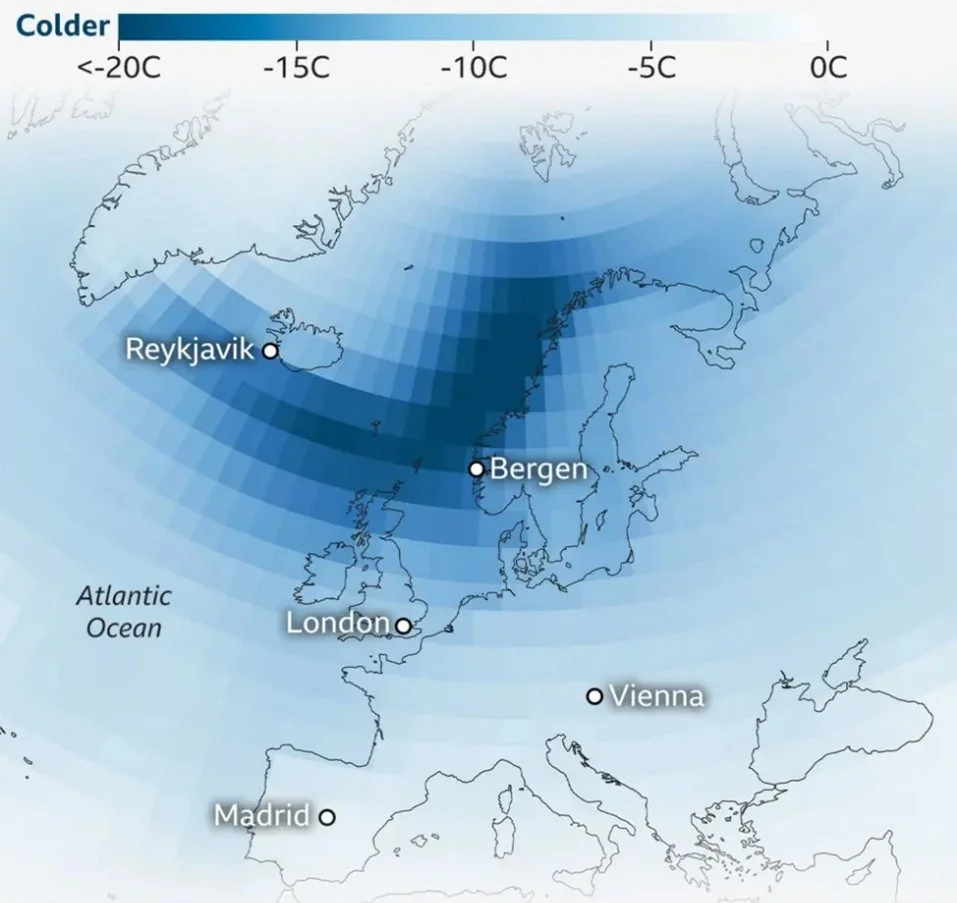Global Tipping Points Conference 2025
Edward Forman
Amid another summer of record-breaking temperatures, climate change is approaching dangerous “tipping points” capable of causing large-scale, abrupt change. Given the importance, scientists gathered in July at the University of Exeter, to discuss these thresholds, for the second Global Tipping Points Conference.
The effects of climate change are becoming more apparent, and the driver – greenhouse gas emissions from human activity – is still increasing. The resultant rising temperatures are threating to force many parts of the Earth’s climate system beyond critical thresholds and lead to large-scale, and potentially irreversible change.
Attendees gathered to discuss these physical thresholds, as well as positive societal thresholds – where social change can become self-sustaining and have a big countervailing effect on negative human impact.
With science telling us many tipping points could be crossed between 1.5 and 2°C of warming, the need for significant decarbonisation has never been greater. This conference was a “call to action” to raise awareness and promote the importance of tipping points, with a view to accelerating action.
What are Tipping Points?
Much like leaning back on a chair, small changes can, after a certain point, lead to large, self-perpetuating system shifts: that is when you fall backwards. This point is referred to as a critical threshold or tipping point and can be used to describe many phenomena in both the physical and social sciences.
A common metaphor likens a given system to a ball in a landscape of hills and valleys. Each valley represents a stable state – conditions here are long-lasting and self-sustaining. The shape of a valley – how wide and deep it is – represents the resilience of the stable state: a ball within a wide, deep valley can move much more without rolling over the hill. With natural variability the ball does move around, but it remains in the valley. However, given enough external forcing, the ball could be pushed out and over a hill – a tipping point – where it rolls down into a new valley. Once this happens, it becomes very difficult, and sometimes impossible, to push the ball back to its original stable state. See Figure 1.
Figure 1
Schematic of the tipping point analogy. Annotations with a black background correspond to a climate change example.
External forcing can also weaken the resilience of a stable state – flatten out the valley – to the point where natural variability can cause a tipping point to be crossed. This is something that can happen when two systems are linked: the tipping of one can tip or weaken another. When this happens a series of tipping points can be crossed – a tipping cascade. For example, the melting of the Greenland Ice Sheet releases freshwater, which weakens the ocean currents in the Atlantic, leading to heat accumulation in the Southern Hemisphere, and Antarctic ice sheet melting as a result.
Climate Tipping Points
The conference opened with discussion of Earth system tipping points and their potential to lead to amplifying feedbacks which bring about potentially irreversible and abrupt climate change. Tipping points in the climate system are well defined, but their locations and impacts are still largely unknown. We do know that many tipping points are at risk under the ~2.9°C of warming forecast by current policies.
However, the risks do not scale in a linear way. Feedbacks and connections between elements mean that the risks amplify disproportionately to temperature rise. This is not only a reason to strive for better climate policy but also highlights an important pitfall of non-scientific target-based action. The Paris Agreement in 2015 set a target to ‘limit global warming to well below 2 °C above pre-industrial levels, while also pursuing efforts to limit the increase to 1.5 °C’. This target was not based on scientific consensus but was chosen and agreed upon by policymakers. However, if 1.5 °C is officially surpassed, as seems likely, the risk of passing a climate tipping point could rise sharply. In this context, 2 °C may pose significant additional risks, and the definition of “well below 2°C” could prove to be pivotal.
Alongside discussions, new science was also presented, which included:
The announcement of a major new modelling initiative called TIPMIP. This framework will be used to model and investigate climate overshoot and tipping points.
Several new studies focused on Antarctica. The Ross ice shelf was shown to tip between 3.5 and 4°C and the circumpolar current was hypothesised to have already crossed a tipping point as it is becoming more saline.
A new programme (WhatIfMIP), which will look at the possibility of cascades with an emphasis on ecological shifts.
A study focused on the impacts of ecological regime shifts on ecosystems and people. The authors find that 26% of the global land area, and with it 3.4 billion people are at risk.
A tipping point with direct implications for Brighton & Hove is the Atlantic Meridional Overturning Circulation (AMOC) – the system of ocean currents responsible for delivering heat to Northern Europe. Other research presented at the conference highlighted that the AMOC may contain several regional tipping points, capable of leading to internal cascading effects. Science has previously shown an AMOC collapse would lead to cooling of up to 15°C in Northern Europe and that winters here in Brighton & Hove could reach -16°C on a 10-year reoccurrence.
The AMOC is one of the most studied tipping points, but when a threshold could be reached remains heavily debated. This is due to measurements only starting in 2004, and so climate models or proxy data is needed to contextualise observations. A new study published after the conference presents new evidence that the AMOC has been weakening for ~300 years and so may be more sensitive and closer to a tipping point than previously thought. See Figure 2.
Figure 2
Map of some of the known climate tipping points. Arrows show the interactions between tipping points and the potential of cascades.
Source: Figure adapted from Timothy M. Lenton et al, 2019.
Positive Tipping Points
In recent years, the tipping points concept has also been applied to the social sciences. While these are not yet completely defined and differ from the climate application, they are social transformations that lead to feedbacks which are self-enforcing and hard to overturn.
There are several examples of these social/positive tipping points, including: rapid EV adoption in Norway, tree-planting schemes in Uganda, increasing popularity of plant-based diets, and falling costs and rising deployment of solar energy around the world.
This thinking changes the narrative from needing to oversee a complete change to only helping a project become competitive, after which further changes can happen autonomously. This is what we saw with the cost of solar energy, which has now fallen by ~99.8% in the last 50 years.
A large part of the conference was spent discussing potential positive tipping points, but with the infancy of the science there are still many questions and ongoing debates (such as whether the global food system could have a tipping point).
Implications for Brighton & Hove
If climate tipping points are triggered, they could substantially alter the future climate of Brighton & Hove. Taking an AMOC collapse as an example, locally we could see cooling even under global warming. With a stable AMOC, Brighton & Hove annual temperatures would warm by ~3.9°C in a 2°C global warming scenario. However, were the AMOC to collapse, under 2°C of warming local temperatures would actually fall by 2.2°C. Whether this tipping point is crossed has a 6.1°C effect of future temperatures, which would have serious ramifications for any climate change adaptation planning in Brighton & Hove. See Figure 3.
Figure 3
Map of possible average air temperature change after an AMOC collapse.
Source: Figure from the BBC and based on René M. van Western et al, 2024.
As the AMOC example shows, tipping points can greatly affect the future climate of Brighton & Hove. Climate change is not as simple as a 2°C temperature rise meaning the climate here is 2°C hotter: these are global averages with variable regional consequences. Additional impacts besides just temperature also complicate things. For example, while a location may experience little to no change, the strong temperature gradient with nearby areas will lead to more frequent extreme weather and redistributed precipitation patterns. More research is greatly needed in the climate tipping point space to help us plan with greater prudency.
While the science continues to improve predictions, we need to acknowledge the complexity of climate change and incorporate scenarios like potential cooling into plans. Also, the theory behind these tipping points needs to be understood, so as to not cause confusion and scepticism when talking about seemingly conflicting ideas (such as regional cooling with global warming).
As the conference concluded, positive tipping points offer great potential in terms of climate action. Given the right strategy we could actively try and trigger these events, and after which progress would become self-sustaining. Aiding the development of renewable energy and the use of EVs are two examples where new policies could be more impactful than they seem.
_____
Edward Forman is on a PhD programme at the University of Southampton
Perspective pieces are the responsibility of the authors, and do not commit Climate:Change in any way. Guest posts are published to explore issues or stimulate debate. Comments are welcome.



